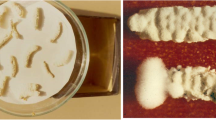Abstract
Field trials were conducted in 1971–1974 to control the honeydew moth,Cryptoblabes gnidiella Mill, withBacillus thuringiensis. Dipel, a commercial preparation containingBacillus thuringiensis var.kurstaki (HD-1 strain), was highly effective (at concentrations ranging from 0.25% to 1.5%) in killing caterpillars of all developmental stages. In both the field trials and additional laboratory trials, it had no adverse effect on the mealybugPseudococcus longispinus Targ.-Tozz., or on its parasites,Hungariella peregrina Compere andAnagyrus fusciventris Girault.
Similar content being viewed by others
References
Anderson, S.F. (1917) Outdoor culture of the grapevine in New Zealand.N.Z. Jl Agric. 14: 278–292.
Avidov, Z. andGothilf, S. (1960) Observations on the honeydew moth (Cryptoblabes gnidiella Milliere) in Israel. I. Biology, phenology and economic importance.Ktavim 10: 109–124.
Bodenheimer, F.S. (1930) Die Schädlingsfauna Palästinas. P. Parey, Berlin.
Bodenheimer, F.S. (1951) Citrus Entomology. Dr. W. Junk, The Hague. pp. 55–58.
Klein, H.Z. (1940) [Citrus Pests in Israel.] Hassadeh Library Publ. Co., Tel Aviv. pp. 143–146. (in Hebrew)
Moore, I., Halperin, J. andNavon, A. (1962) Laboratory and field trials in the bacterial control of the pine processionary caterpillarThaumetopoea wilkinsoni Tams. withBacillus thuringiensis var.thuringiensis Berliner.Israel J. agric. Res. 12: 167–174.
Moore, I. andNavon, A. (1973) Studies of the susceptibility of the cotton leafworm,Spodoptera littoralis (Boisduval), to various strains ofBacillus thuringiensis.Phytoparasitica 1: 23–32.
Sayed, M.T. (1946)Aceria mangiferae nov. spec. (Eriophyes mangiferae Hassan M.S.) (Acarina-Eriophyidae).Bull. Soc. Fouad I Ent. 30: 7–10.
Schweig, K. (1950) [Pests of Grapevine and Deciduous Fruit Trees.] Hassadeh Library Publ. Co., Tel Aviv. (in Hebrew)
Silvestri, F. (1951) Compendio di Entomologia Applicata. Vol. 2. Tipografico Guglielmo Genovese, Napoli.
Willcocks, F.C. (1922) A survey of the more important economic insects and mites of Egypt.Bull. Sultanieh agric. Soc. Cairo 1: 29, 57, 65, 72, 135, 291, 293, 348.
Wysoki, M., Izhar, Y., Swirski, E., Gurevitz, E. andGreenberg, S. (1975) [The longtailed mealybugPseudococcus longispinus Targ.-Tozz.) on avocado; damage, hosts and susceptibility of avocado varieties.]Alon haNotea 29: 614–623. (in Hebrew)
Author information
Authors and Affiliations
Additional information
Publication of the Agricultural Research Organization. 1975 Series, No. 162-E.
Rights and permissions
About this article
Cite this article
Wysoki, M., Izhar, Y., Gurevitz, E. et al. Control of the honeydew moth,Cryptoblabes gnidiella Mill. (Lepidoptera: Phycitidae), withBacillus thuringiensis berliner in avocado plantations. Phytoparasitica 3, 103–111 (1975). https://doi.org/10.1007/BF03158292
Received:
Accepted:
Issue Date:
DOI: https://doi.org/10.1007/BF03158292




